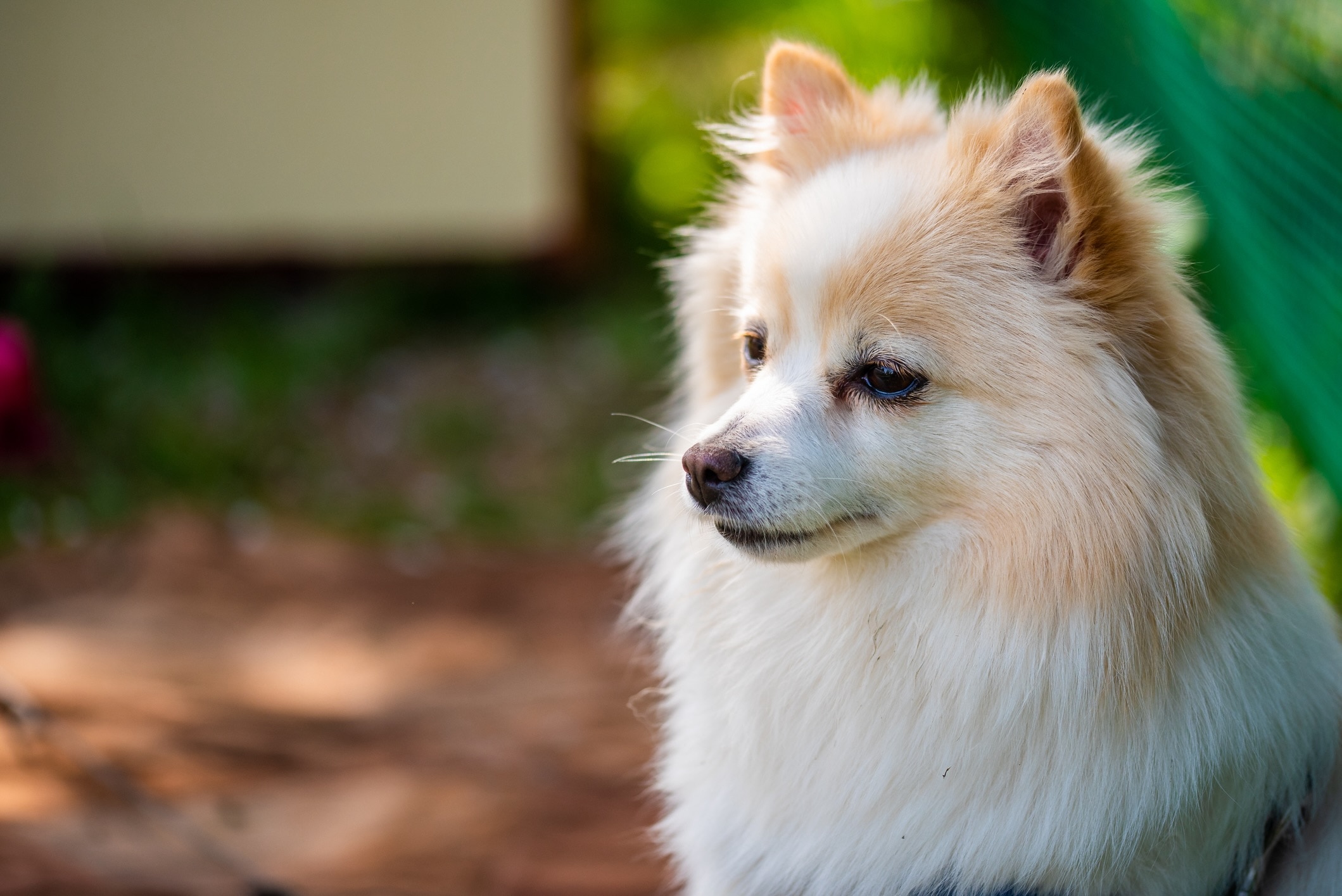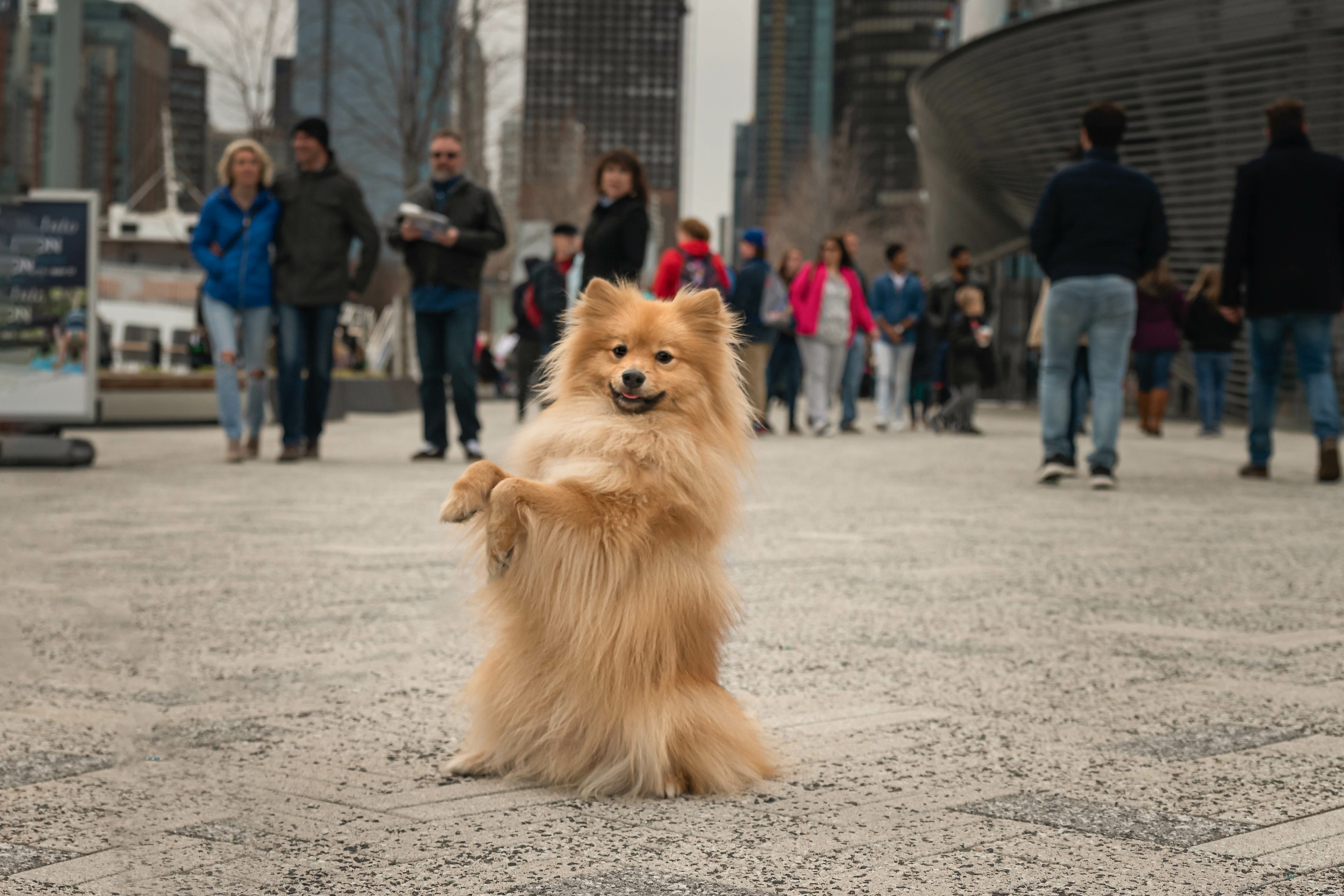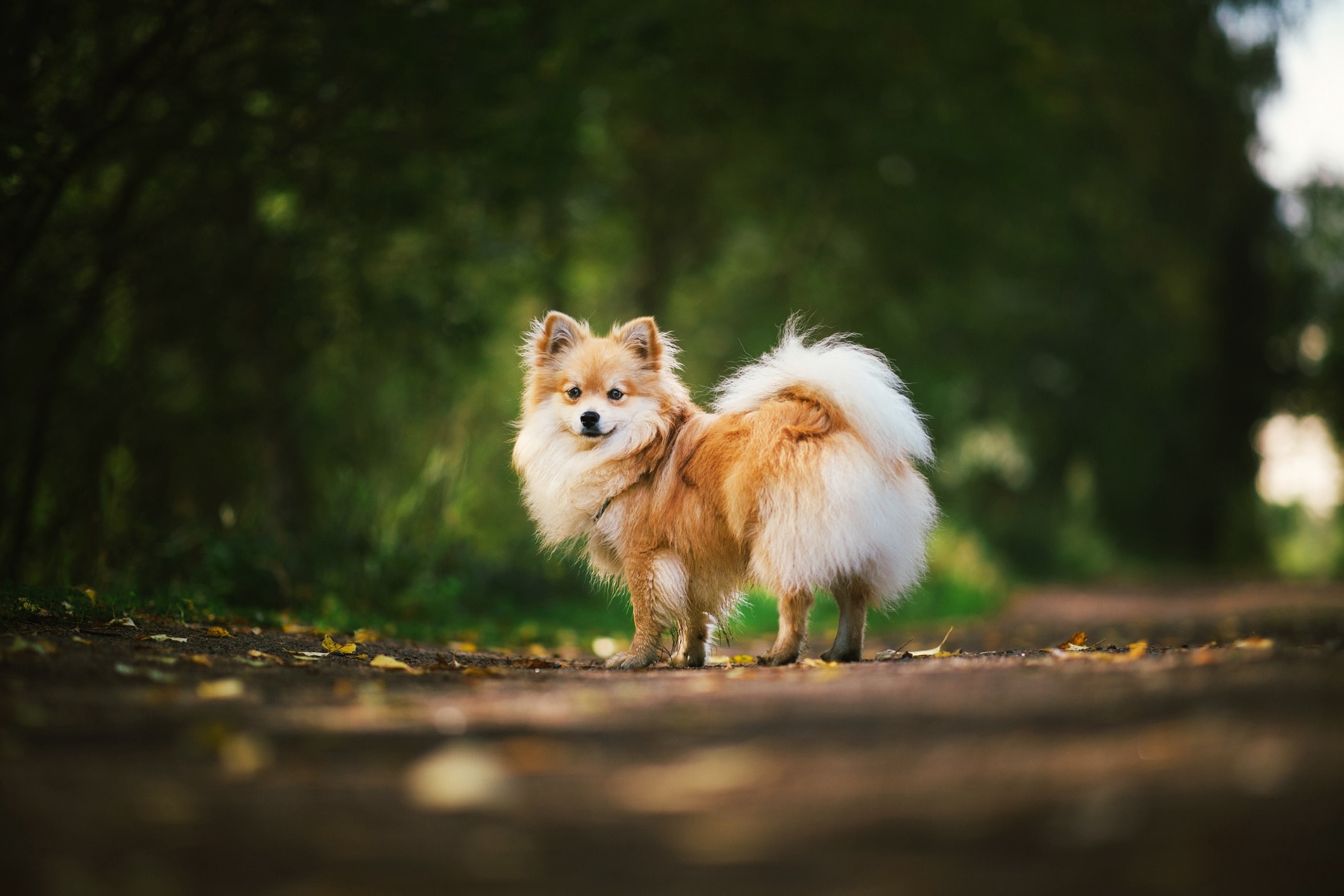German Spitz
Adobe Stock/Jess Wealleans
There’s evidence to suggest that the fox-faced German Spitz is one of the oldest European dog breeds. This highly intelligent, densely coated dog was originally bred in the Middle Ages for guarding and herding before becoming a popular companion breed in the 1700s, according to the German Spitz Club of America (GSCA).
This breed has a fluffy double coat, small triangular ears, and a thick tail that’s generally held up and over their back. There are three sizes of German Spitz dogs, which allows them to flourish in many households:
-
Toy German Spitz stand 8–12 inches tall and weigh 10–11 pounds
-
Medium German Spitz stand 12–16 inches tall and weigh 15–25 pounds
-
Large German Spitz stand 16–20 inches tall and weigh 30–50 pounds
Caring for a German Spitz
Unlike the dogs’ smaller cousin, the Pomeranian, the German Spitz is still a working dog that prefers to be active and is more independent. They are intelligent and very trainable, and can make great family dogs as long as they are kept engaged. Spitz do best with older children who recognize the dog’s boundaries.
Originally bred to be guardians, Spitz dogs tend to be very vocal. This can be managed with training, but be prepared for your pup to tell you when people are approaching your home—even if it’s just a delivery person. Though reserved around strangers, German Spitz will usually get along well with other family dogs and pets as long as they are introduced properly.
Properly caring for a German Spitz dog’s long double coat is extremely important for their health. These dogs need brushing at least every other day to avoid matting, which can cause painful skin problems. This heavy coat is important to keeping a German Spitz both warm in the winter and cool in the summer, so shaving their hair short is not recommended.
The German Spitz is an active breed, but they’re not built for prolonged activity. One to two hours of exercise a day should be plenty to keep them happy. Be cautious exercising with these pups in hot climates or over long distances, as they can overheat quickly.
German Spitz Health Issues

The German Spitz breed is overall a very healthy dog with few major health concerns. In fact, this breed has actually been used multiple times to improve the health of other similar breeds during their history. That said, there are some issues to ask your breeder about and monitor for as your pup ages.
Collapsing Trachea
Collapsing trachea results from a progressive weakness in the cartilage rings of the windpipe (trachea) as a predisposed dog ages. This weakness allows a portion of the trachea to narrow as a dog breathes, resulting in a honking cough. This cough is particularly common when an affected dog gets excited or has pressure placed on their neck with a collar or leash.
Intermittent coughing may respond to weight loss, cough suppressants, activity level changes, and environmental changes like using a harness instead of a collar. In severe cases, surgery for this disease may be needed to help support the trachea.
Patellar Luxation
A common syndrome in small-breed dogs, patellar luxation happens when the kneecap no longer sits properly in the knee joint and moves (luxates) to either side as a dog walks or runs. Mild cases may only be noted by your veterinarian on a physical exam, while more severe cases may result in a hopping, three-legged gait.
Many cases are managed medically with joint supplements and weight control. Severe cases that result in other ligament damage or an inability to move the leg properly may require surgery.
Progressive Retinal Atrophy
Progressive retinal atrophy (PRA) has been associated with a specific gene mutation in the German Spitz dog breed. This disease results in the gradual deterioration of the cells in the back of the eye that receive light and send signals to the brain. The loss of these cells results in gradual blindness, usually over one to two years.
Initially, signs of PRA can be hard to spot. Dogs may seem clumsy in dim light, especially in unfamiliar surroundings. Their pupils may seem excessively large (dilated), and in late stages of the disease you may notice an abnormal reflection from the eye.
There is no treatment of PRA, though it isn’t painful, and most dogs adjust well to blindness given their other keen senses. Screening tests are available for the gene mutation, and reputable German Spitz breeders can have their dogs tested for this disease.
What To Feed a German Spitz
The German Spitz has no specific nutritional needs as a household companion. Choose a well-balanced commercial dog food that’s formulated for their age range (puppy, adult, or senior). Small-breed diets are reasonable for the smaller members of this breed to ensure they can comfortably chew the kibble size.
How To Feed a German Spitz
German Spitz puppies under 4 months of age may benefit from frequent, small meals (four or five per day) to avoid low blood sugar, which can be seen in small-breed puppies.
As an adult, your German Spitz should be satisfied with two to three meals a day. Feeding one or more of those meals in a puzzle feeder may help keep a Spitz’s active brain sharp and focused.
How Much Should You Feed a German Spitz?
Carefully measure or weigh your pup’s food and feed according to the label recommendations of your chosen diet. Keep in mind that individual German Spitz dogs will be different sizes and have different activity levels, and therefore different calorie needs.
If you’re concerned that your pup is putting on too much weight, discuss calorie goals with your veterinarian. Don’t forget to include training treats and dental chews in your calorie calculations. Small changes can be a big deal in smaller dog breeds like the German Spitz.
Nutritional Tips for German Spitz Dogs
If you feed a balanced commercial diet that meets the standards set by the Association of American Feed Control Officials (AAFCO), your German Spitz should not need nutritional supplements. Do not give your dog supplements without talking to your vet first.
Behavior and Training Tips for German Spitz Dogs
German Spitz Personality and Temperament

The German Spitz is generally regarded as a friendly and independent breed. Their history as a working dog makes them an active member of the family, but they have been bred to be companions for decades.
They are much happier running around the yard than they are lying on the couch, and they would love nothing more than to play games and learn new activities.
German Spitz Behavior
These dogs retain many of their guardian and herding tendencies. This means German Spitz can be more reserved around strangers and are prone to bark at anything—and anyone—new. This behavior can be managed with training, but it will not be stopped completely—and you should be prepared for some high-pitched vocalizations in your home.
Because German Spitz were originally bred for herding, the breed tends to retain a strong prey and chase drive. Agility training and chase-based games can turn this behavior into an activity for you both to enjoy. Be aware that they may be distracted by fast-moving children and smaller pets, so these interactions should be closely monitored.
German Spitz Training
The German Spitz, like many other highly intelligent breeds, take a bit of extra persuasion during training. They respond best to consistent training efforts with positive reinforcement. They will likely learn a trick right away but spend a lot of time testing how serious you are about the command.
Socializing your German Spitz puppy is important, especially considering their history as guardians. Socialization will help your dog be more comfortable and confident not only around new people, but also in new situations and when exposed to new stimuli.
Fun Activities for German Spitz
-
Heelwork to music
-
Obedience
-
Freestyle
German Spitz Grooming Guide

Though the German Spitz’s thick coat may seem daunting, it can be quite manageable to care for. Consistent brushing (ideally every other day) is the most important step, and this can become a great bonding routine for you and your pup.
Skin Care
As long as their coat is well cared for, the German Spitz does not need specific skin care. Bathing with a dog shampoo and conditioner can usually be left to every two to three months unless they have managed to get particularly dirty.
Coat Care
Spitz dogs have a double coat: a long and straight overcoat with a soft, almost wool-like undercoat. Thorough brushing is necessary multiple times per week to keep this thick coat from getting tangled and matted.
The German Spitz usually sheds their coat twice a year over a span of two to three weeks. Otherwise, shedding is minimal with routine brushing.
It’s extremely important that you don’t shave or close-clip a German Spitz’s thick coat unless medically necessary to relieve matting. The inner and outer layers work together to keep these dogs warm in the winter and also cool in the summer. Shaving either layer can significantly throw off their temperature balance.
Eye Care
Heathy German Spitz should not need any special eye care. Routine veterinary visits are recommended to monitor their vision for signs of progressive retinal atrophy.
Ear Care
German Spitz do not require special care for their ears. Ask your vet if cleaning your dog’s ears is necessary and, if so, which ear cleaning products to use.
Considerations for Pet Parents

The German Spitz can be a wonderful addition to your family if you’re looking for a highly interactive companion. These dogs thrive on attention and play, and will do especially well if given a job. Training and grooming the German Spitz requires time and dedication, but it’s not exceptionally difficult once a routine is established.
This small to medium breed is generally healthy and, if well cared for, lives 13–15 years on average. They can be standoffish with strangers, but they are extremely affectionate once they decide you are friends.
German Spitz FAQs
Is a German Spitz a Pomeranian?
No. The Pomeranian and German Spitz are closely related, but the Pomeranian is generally smaller and has been bred as a companion for longer than the German Spitz, which was originally a working dog.
Are German Spitz good pets?
Yes, modern German Spitz dogs have been bred as companions, and make excellent pets as long as their families are dedicated to training and regularly involve them in activities. They are extremely playful and affectionate with people they know.
Can German Spitz be left alone?
German Spitz dogs prefer to be the center of attention and need active mental stimulation. That said, they can be trained to be left alone safely for reasonable periods.
Are German Spitz expensive?
The German Spitz price depends on a few factors, such as the dog’s bloodline, the breeder you work with, and where you live. You could pay around $3,000 for a German Spitz puppy from a breeder.
What colors are German Spitz?
There are wolf gray, white, red, cream, orange, brown, black, and tan, and black German Spitz dogs.

